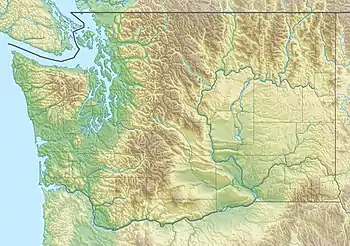Moclips River
The Moclips River is a river in the U.S. state of Washington. It is about 12 miles (19 km) long. Its main tributary, the North Fork Moclips River, is longer than the main stem. The length of the North Fork, along with the lower main stem below the North Fork's confluence, is 17 miles (27 km).[2] The drainage basin of the Moclips River is 22.4 square miles (58 km2) in area.[3]
| Moclips River | |
|---|---|
 Location of the mouth of the Moclips River in Washington  Moclips River (the United States) | |
| Location | |
| Country | United States |
| State | Washington |
| County | Grays Harbor |
| Physical characteristics | |
| Source | Macafee Hill |
| • coordinates | 47°16′27″N 124°2′33″W[1] |
| Mouth | Pacific Ocean |
• coordinates | 47°14′52″N 124°13′10″W[1] |
• elevation | 0 ft (0 m) |
| Length | 12 mi (19 km)[2] |
| Basin size | 22 sq mi (57 km2)[3] |
Course
Both the Moclips River and its main tributary, the North Fork Moclips River, originate on the slopes of Macafee Hill. Both flow generally west. The North Fork joins the main river about 2 miles (3.2 km) from the Pacific Ocean. The Moclips River empties into the Pacific near Moclips.
History
According to Edmond S. Meany the word moclips comes from a Quinault word meaning a place where girls were sent as they were approaching puberty.[4] However, according to William Bright, the name comes from the Quinault word meaning, simply, "large stream".[5]
See also
References
- U.S. Geological Survey Geographic Names Information System: Moclips River
- "National Hydrography Dataset". United States Geological Survey. Retrieved 4 September 2010. ArcExplorer GIS data viewer.
- "Watershed Boundary Dataset". USDA, access-date=4 September 2010 |NRCS, National Cartography & Geospatial Center. ArcExplorer GIS data viewer.
- Meany, Edmond S. (1920). "Origin of Washington Geographic Names". The Washington Historical Quarterly. Washington University State Historical Society. XI: 207. Retrieved 2009-06-11.
- Bright, William (2007). Native American placenames of the United States. University of Oklahoma Press. p. 292. ISBN 978-0-8061-3598-4.